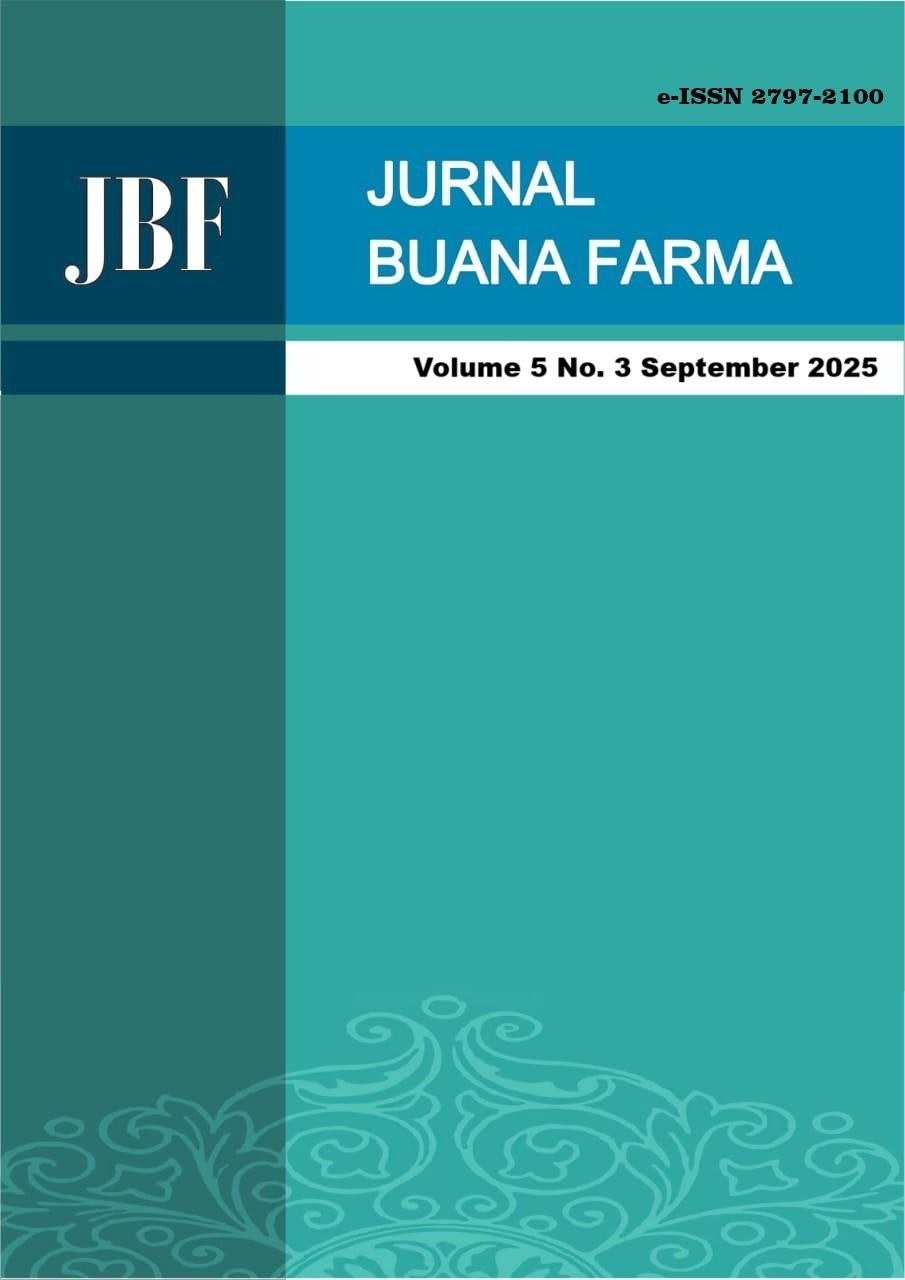FORMULASI SIRUP DEKOKTA KERANG TUDE BOMBANG (Atactodea striata) SEBAGAI HEPATOPROTEKTOR ALAMI
Abstract
The Tude Bombang clam (Atactodea striata) is a potential hepatoprotective agent due to its bioactive protein content and low fat levels, which contribute to liver protection through antioxidant activity, hepatocellular repair, and prevention of lipid accumulation in liver cells. This study aimed to formulate a decoction syrup of Tude Bombang clam and evaluate its hepatoprotective effects against paracetamol-induced hepatotoxicity in mice, as well as assess its organoleptic properties, homogeneity, and pH. The results showed that SGOT and SGPT levels in the normal control group remained stable (SGOT: 17.7–17.2 U/L; SGPT: 7.5–7.2 U/L), whereas the negative control group exhibited persistent elevations (SGOT: 374.7–373 U/L; SGPT: 97.2–95.6 U/L), confirming liver damage. The positive control (curcumin) reduced SGOT to 220.3 U/L and SGPT to 102.4 U/L. The Tude Bombang clam syrup demonstrated dose-dependent hepatoprotective effects, with the 60% concentration producing the most significant reductions in SGOT (350.9 to 288.9 U/L) and SGPT (96 to 73.6 U/L), indicating its ability to stabilize liver enzymes and mitigate hepatocellular injury. Organoleptic evaluation revealed acceptable sensory characteristics, homogeneity testing confirmed uniform dispersion without sedimentation, and the pH values (7.02–7.20) fell within the neutral range recommended for oral syrups. Overall, the Tude Bombang clam syrup exhibited favorable physical properties and hepatoprotective potential through its bioactive protein content and low fat levels, making it a promising candidate for functional hepatoprotective formulations.
References
Anggarani MA, Purnama ER, & Dalilah Aziz JSI. (2021). Antioxidant Potential of the Shell of Razor Clams (Solen spp) in Antidiabetic Mellitus Type II Therapy. Journal of Physics: Conference Series. 1899(1). https://doi.org/10.1088/17426596/1899/1/012060.
Atwater WO, & Woods CD. (1899). The Chemical Composition Of American Food Materials. Science. 10(248):461–462.
https://doi.org/10.1126/science.10.248.461
Bai J, Chen Y, Ning Z, Liu S, Xu C, & Yan JK. (2020). Proteoglycan Isolated From Corbicula Fluminea Exerts Hepato-Protective Effects Against Alcohol-Induced Liver Injury In Mice. International Journal of Biological Macromolecules. 142:1–10.
https://doi.org/https://doi.org/10.1016/j.ijbiomac.2019.12.001
Bian C, Wang J, Zhou X, Wu W, & Guo R. (2020). Recent Advances on Marine Alkaloids from Sponges. Chemistry & Biodiversity. 17(10);e2000186. https://doi.org/10.1002/cbdv.202000186
Biosci IJ, Villabeto SC, Rosario RMD, & Canencia OP. (2019). Yields, Zoochemical Profiles, And Antioxidant Activities Of Extracts From Freshwater Clam (Corbicula fluminea) Using Different Solvents. International Journal of Biosciences (IJB). 14(01):174–182. https://doi.org/10.12692/ijb/14.1.174-182.
Debojyoti Basu PDDJS. (2015). Organoleptic Agents: Adaptability, Acceptability and Palatibilty in Formulations to Make it Lucrative. World Journal Of Pharmacy And Pharmaceutical Sciences. 4(10):1573–1586.
Gao J, Zhang C, Qin X, Cao W, Chen J, Li Y, Zheng H, Lin H, & Chen Z. (2022). Hepatoprotective Effect Of Clam (Corbicula fluminea) Protein Hydrolysate On Alcohol-Induced Liver Injury In Mice And Partial Identification Of A Hepatoprotective Peptide From The Hydrolysate. Food Science and Technology (Brazil). 42:1–10.
https://doi.org/10.1590/fst.61522
Hadrian E, Sari AP, Mayanti T, Harneti D, Maharani R, Darwati D, Farabi K, Supratman U, Waranmaselembun C, Salam S, Fajriah S, & Azmi MN. (2023). Steroids from Atactodea striata and Their Cytotoxic Activity against MCF-7 Breast Cancer Cell Lines. 23(1): 200–209. https://doi.org/10.22146/ijc.76438
Hanuf Nuzzaibah, & Nur Ermawati. (2023). Formulasi Dan Evaluasi Sediaan Sirup Antipiretik Ekstrak Daun Jeruk Nipis (Citrus aurantifolia L.). Jurnal Medika Nusantara. 1(2): 25–39.
https://doi.org/10.59680/medika.v1i2.272
Hsu CL, Hsu, CC, & Yen GC. (2010). Hepatoprotection by Freshwater Clam Extract Against CCl4-Induced Hepatic Damage in Rats. The American Journal of Chinese Medicine. 38(05):881–894. https://doi.org/10.1142/S0192415X10008329.
Jumrawati J, Angreni H, & Syahrin MA. (2024). The Effect of Boiled Water of Kemis Mas Ngur (Atactodea striata) on The Nutrition and Organoleptics of Noodle Sauce. Jurnal Biologi Tropis. 24(4):1026–1033. https://doi.org/10.29303/jbt.v24i4.8035
Junaidi A, & Zelika MR. (2018). Potensi Silymarin (Hepamax) Sebagai Suplemen Dan Terapi Penunjang Pada Gangguan Liver. Farmaka. 16(1): 119–126.
Karaulova EP, & Yakush EV, Slutskaya TN, Shulgina LV. (2021). Hepatoprotective Activity of Three Species of Shellfish of the Pacific Coast of Russia. Molecules. 26(11): 3397.
Latimer Jr GW. (2023). AOAC Official Method 920.153Ash of Meat. In Official Methods of Analysis of Aoac International (p. 0). Oxford University Press. https://doi.org/10.1 093/9780197610145.003.3438.
Latimer Jr GW. (2023). AOAC Official Method 928.08Nitrogen in Meat: Kjeldahl Method. In Official Methods of Analysis of Aoac International (p. 0). Oxford University Press 2023b. https://doi.org/10.1093/978 0197610145.003.3445
Latimer Jr GW. (2023). AOAC Official Method 960.39Fat (Crude) or Ether Extract in Meat. In Official Methods of Analysis of Aoac International (p. 0). Oxford University Press. https://doi.org/10.1093/9780197610145.003.3434
Liao N, Chen S, Ye X, Zhong J, Wu N, Dong S, Yang B, & Liu D. (2013). Antioxidant and Anti-Tumor Activity Of A Polysaccharide From Freshwater Clam, Corbicula fluminea. Food & Function. 4(4):539–548. https://doi.org/10.1039/C2FO30178D.
Lin JJ, Liu YC, Chang CJ, Pan MH, Lee MF, & Pan BS. (2018). Hepatoprotective Mechanism Of Freshwater Clam Extract Alleviates Non-Alcoholic Fatty Liver Disease: Elucidated In Vitro And In Vivo Models. Food & Function. 9(12):6315–6325. https://doi.org/10.1039/C8FO01758A
Liu C, Li T, Liu E, Li C, Wang A, & Gu Z. (2019). Proximate Composition, Amino Acid Content, and Fatty Acid Profile of the Adductor Muscle and Mantle from Two Species of the Giant Clams Tridacna crocea and Tridacna squamosa. Journal of Shellfish Research. 38(3): 529–534. https://doi.org/10.2983/035.038.0303.
Mohamed A, Gamal M, Elzayat E, & Suliman H. (2021). Sea Cucumbers-Saponin Ameliorates Hepatorenal Toxicity Induced By Gentamicin In Rats. GSC Biological and Pharmaceutical Sciences. 14:129–136. https://doi.org/10.30574/gscbps.2021.14.3.0069.
Moka W. (1982). Identifikasi dan Inventarisasi Jenis kerang Laut Yang Digunakan Sebagai Obat Tradisonal Di Sulawesi Selatan. Makassar: Universitas Hasanuddin.
Mulawarmanti D. (2019). Marine Biota As An Alternative Medicine (Use Of The Gold Sea Cube As Advanced Therapy In Dental): Prosiding Seminakel.
Palawe CY, Kairupan CF, & Lintong PM. (2021). Efek Hepatoprotektif Tanaman Obat. Medical Scope Journal. 3(1):61–73. https://doi.org/10.35790/msj.v3i1.33542
Pradana RC. (2022). Physical Test Herbal Syrup of Emprit Ginger (Zingiber Officinale Var. Amarum) and Lime (Citrus Aurantifolia Swingle) for Body Fitness. Jurnal Jamu Kusuma. 2(1):1–7.
https://doi.org/10.37341/jurnaljamukusuma.v2i1.27.
Sitorus DS, & Desiani A. (2024). Hepatitis Disease Diagnosis Expert System Using Certainty Factor Method: Hepatitis Disease Diagnosis Expert System Using Certainty Factor Method. Jurnal Mahasiswa Teknik Informatika. 3(1): 212–219.
Souza CRM, Bezerra WP, & Souto JT. (2020). Marine Alkaloids with Anti-Inflammatory Activity : Current Knowledge and Future Perspectives. Marine Drugs. 18(3):147. https://doi.org/10.3390/md18030147.
Sun Y, Dong Y, Cui X, Guo X, Zhang J, Yu C, Zhang M, & Wang H. (2024). Effects of Marine Natural Products on Liver Diseases. Marine Drugs. 2;288.
https://doi.org/10.3390/md22070288
Trisyani N, & Yusan LY. (2020). Proximate analysis and amino acid profile in fresh meat , meat meal , and shell meal of bamboo clam Solen sp . from Kwanyar Coast, Bangkalan-Madura, Indonesia. AACL Bioflux. 13(5): 2921–2927.
Valenzuela A, Oyarzún PA, Toro JE, Navarro JM, Ramírez O, & Farias A. (2022). Proximal and Fatty Acid Analysis In Ostrea chilensis, Crassostrea gigas and Mytilus chilensis (Bivalvia: Mollusca) from southern Chile. PLOS ONE. 17(7):e0270825. https://doi.org/10.1371/journal.pone.0270825.
Wang L, Yang Y, Tan H, Li S, & Feng Y. (2020). Protective Actions of Acidic Hydrolysates of Polysaccharide Extracted From Mactra veneriformis Against Chemical-Induced Acute Liver Damage. Front Pharmacol. 11; 446. https://doi.org/10.3389/fphar.2020.00446
Wang Q, Liu FJ, Wang XM, Zhao GH, Cai D, Yu JH, Yin FW, & Zhou DY. (2022). Preparation and Hepatoprotective Activities of Peptides Derived from Mussels (Mytilus edulis) and Clams (Ruditapes philippinarum). Marine Drugs. 20(11). https://doi.org/10.3390/md20110719.
Wen X, Chen A, Wu Y, Yang Y, Xu Y, Xia W, Zhang Y, Cao Y, & Chen S. (2020). Comparative Evaluation Of Proximate Compositions And Taste Attributes Of Three Asian Hard Clams ( Meretrix meretrix ) with different shell colors. International Journal of Food Properties. 23(1):400–411. https://doi.org/10.1080/10942912.2020.1733015.
World Health Organization (WHO). (2022). The Global Health Observatory: Hepatitis. 2022. Tersedia di: https://www.who.int/data/gho/data/themes/chronic-viral-hepatitis?utm (diakses: 12 September 2025).
Yu Z, Gao G, Wang H, Ke L, Zhou J, Rao P, Chen T, Peng Z, Zou J, & Luo S. (2020). Identification Of Protein-Polysaccharide Nanoparticles Carrying Hepatoprotective Bioactives In Freshwater Clam (Corbicula fluminea Muller) Soup. International Journal of Biological Macromolecules. 151;781–786. https://doi.org/https://doi.org/10.1016/j.ijbiomac.2020.02.105.













